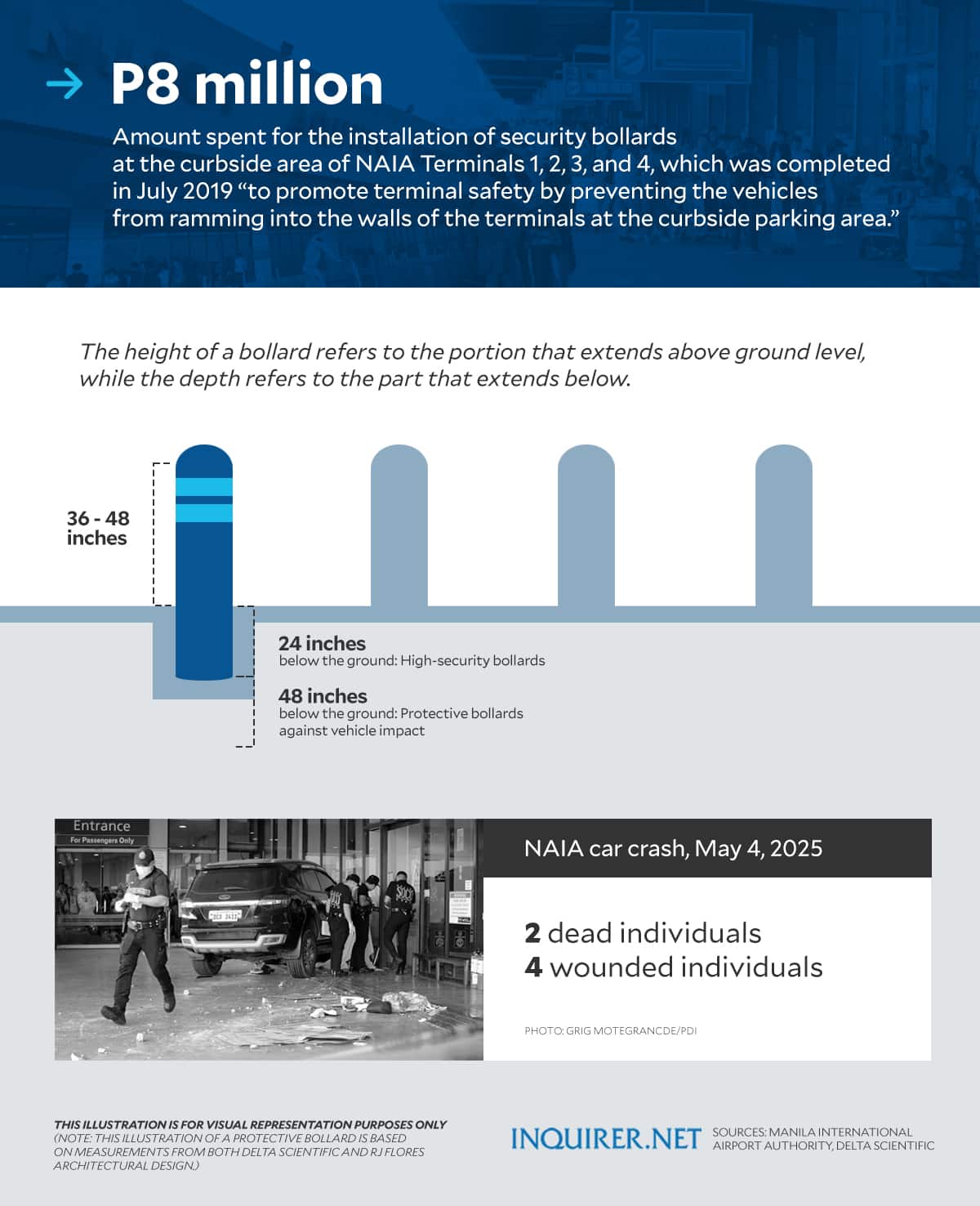Naia car crash: The bollard that failed to protect
MANILA, Philippines—How deep should a bollard be?
As an SUV rammed into a crowd standing close to the entrance of the Ninoy Aquino International Airport (Naia) on Sunday, May 4, and killed two individuals, one of them a five-year-old girl, and wounded four more, a lot of people asked, were the bollards not strong enough that they failed to protect passengers from the impact of the vehicle?
According to a 2019 report by the Manila International Airport Authority (MIAA), the government spent P8 million for the installation of security bollards at the curbside area of Naia Terminals 1, 2, 3, and 4 “to promote terminal safety by preventing the vehicles from ramming into the walls of the terminals at the curbside parking area.” It was completed on July 26 of the same year.
However, at the departure area of Naia Terminal 1, the bollards did not stop the SUV, a Ford Everest, from ramming some passengers it was meant to protect. Transportation Secretary Vince Dizon said both the MIAA and San Miguel Corporation, which now operates Naia, are already conducting an investigation.
READ: Girl, 5, one of two killed in Naia car accident
“So I noticed the bollards […] So you can see there that the bollards were easily toppled, obviously, because the car moved past it. The purpose of bollards is to stop wayward vehicles. So both the MIAA and the San Miguel Corporation are investigating this,”Dizon said in a press briefing, pointing out that the bollards would be replaced.
READ: MIAA, SMC probing, replacing faulty bollards after Naia accident
As explained by the website Delta Scientific, bollards are short, sturdy posts installed in the ground, or just at the surface, to create a boundary between a roadway and a building or pedestrian area. “Bollards allow foot traffic to flow freely while signaling to drivers that vehicles cannot enter a certain area,” it said.
It explained that most bollards have to fall within a certain height and depth range, with some bollard code requirements saying that bollards have to be between 36 and 48 inches tall.
But how about the depth?
Delta Scientific said high-security bollards should have a deep, concrete base that extends at least 24 inches below ground level, with 48 inches giving better protection against vehicle impact.
READ: LOOK: Dad of 5-year-old victim in Naia car crash wails for child’s death
As stated, however, by the RJ Flores Architectural Design, “for public spaces like terminals, crash-rated or anti-ram bollards should be used—typically made of heavy-duty steel with a diameter of six to eight inches, embedded three to five feet deep in reinforced concrete, and spaced three to five feet apart.”
“Bollards play a crucial role in enhancing safety, controlling traffic, and protecting both people and infrastructure. They act as physical barriers that prevent unauthorized vehicle access, accidental crashes, and potential vehicle-ramming incidents, all while guiding pedestrian and vehicular flow,” it said.
READ: Driver in fatal Naia crash tested negative for alcohol, drugs, says police
It stressed that while bollards were present in the Naia area, it seemed they were not designed or installed to withstand vehicular impact, “highlighting the importance of using standard, impact-resistant specifications.”
But in the first place, the area should not have had a parking space, given the heavy pedestrian traffic and the nature of the terminal as a high-footfall zone. “Allowing vehicles to park too close to entrances poses a major risk, and proper spatial planning should prioritize the safety of people over vehicular convenience,” it said.




















